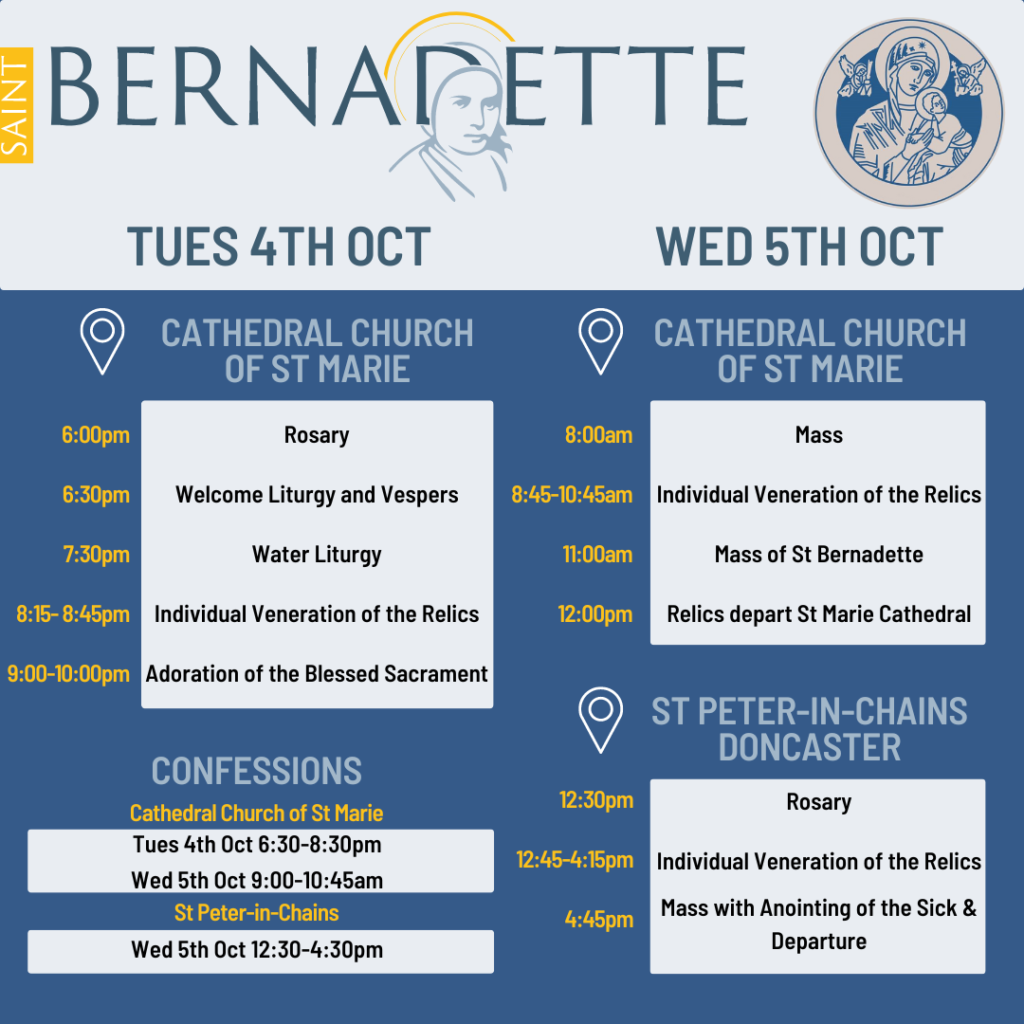Encountering the Relics of St Bernadette
In September and October this year, the relics of St Bernadette will journey on pilgrimage to England, Scotland, and Wales for the very first time. This very special once in a lifetime event will provide an opportunity for people of all ages and backgrounds to experience the special gifts and charisms of Lourdes, in a church or cathedral near them.
We will receive them in Hallam in two venues:
St Marie’s Cathedral in Sheffield, from the 4th of October at 6pm till the 5th of October at 12pm
St Peter in Chains in Doncaster from the 5th of October at 12:30pm till the 5th of October at 6pm
Our liturgies are:
- Tuesday evening St. Marie’s Cathedral.
- 11am Mass Wednesday morning at the Cathedral.
- 4.45pm Anointing Mass at St. Peter-in-Chains, Doncaster.
All welcome – booking is not required

St Bernadette UK Relic Tour – A Pilgrimage of Prayer
Letter from Bishop Ralph
Dear Brothers and Sisters
I am delighted to have this opportunity to invite you to join me on 4th & 5th October for something very special, as we host the relics of St Bernadette. Cardinal Vincent said recently “Relics are important because they are a touchstone – something that helps us to remember, and puts us back in touch”.
You will recall that nearly 165 years ago in Lourdes, Our Lady invited Bernadette, during the 3rd Apparition, to come and see her in these words: “Would you do me the honour of coming here for a fortnight!” Bernadette accepted the invitation of “The Lady” (‘Aquero’ in the local dialect) and that led to Lourdes, a small town in South West France, becoming a place of pilgrimage, prayer and healing, drawing people from all over the world.
The presence of the Relics of St Bernadette among us is an invitation to come together in prayer and celebrate the special gifts of Lourdes here in our Diocese of Hallam. This invitation is for everyone – whether you have ever made a pilgrimage to Lourdes or not.
Whenever Lourdes is mentioned perhaps our first thoughts are of Mary and Bernadette. But we mustn’t forget the special place of the Eucharist in Lourdes – the daily Masses celebrated throughout the day in Lourdes, and, of course, the Blessed Sacrament procession each day.
This should come as no surprise. In the huge dome inside the Rosary Basilica there is an inscription which reads: “Par Marie a Jesus” – “Through Mary to Jesus”.
During the days of journeying with St Bernadette I pray that she will lead us to “The Lady” and that she, in turn, will lead us to a deeper relationship with Jesus, her Son.
I do hope that you will join me at one of the liturgies planned at the Cathedral, and St Peter in Chains, Doncaster, when “Lourdes comes to Hallam”.
Our Lady of Lourdes Pray for us
St Bernadette Pray for us
St Bernadette’s Story
St Bernadette was born in 1844 in a small town in France. Bernadette Soubirous was one of eight children born into a very poor family. Although initially unremarkable, Bernadette’s life was to inspire generations of people to journey in faith on pilgrimage to Lourdes.
Between 11 February and 16 July 1858, Bernadette saw the Virgin Mary eighteen times in a series of Apparitions that took place in cave on the outskirts of Lourdes, a place now known as the Grotto of Massabielle. In the course of these miraculous encounters, Bernadette, then aged just 14, became the friend and confidante of Our Lady, the mother of Jesus.
The Apparitions of Lourdes were authenticated in 1866 by the Bishop of Tarbes. In that same year, Bernadette left Lourdes to live out her religious vocation within the community of the Sisters of Charity of Nevers. She died in 1879, was proclaimed blessed in 1925, and a became a saint in 1933.
If you want to read more about St Bernardette’s and the aparittions please visit: https://stbernadette.org.uk/st-bernadette/
What are the Relics?
A Relic is a part of the physical remains of a saint after their death, or an object which has been in contact with their body. Relics are venerated to honour the holiness of God.
The veneration of relics is found in many religions and is rooted in the natural human instinct to treat anything connected with those we love, who have died, with care and reverence.
From earliest times the bodies of martyrs were held in special veneration. The relics of St Polycarp, for example, were described as being ‘more valuable than precious stones and finer than refined gold.’
In Rome, prayer services were held in the catacombs, and from the fourth century, the Eucharist was celebrated over the tombs of the martyrs. St Augustine explains this by highlighting that the bodies of saints and martyrs had enabled them to live as organs of the Holy Spirit. There are two principle reasons for venerating relics:
- God shows his approval of relics by granting healing, and other graces.
- Relics help us to feel close to a holy person, making the communion of saints more real and fostering in us a desire for holiness.


